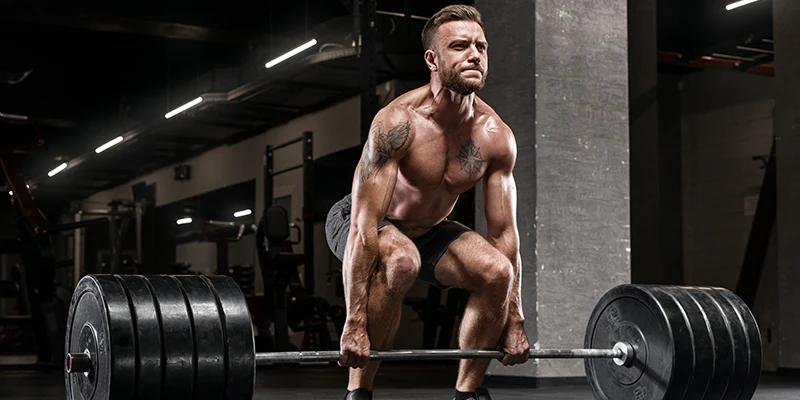90+ Greatest Muscle Building Tips That Works Like Magic

Table of Contents
START YOUR BODY TRANSFORMATION TODAY!
If you want to maximise your muscle gains, then it comes down to how you train, what you eat and lifestyle factors like sleep, recovery and stress.
So we have put together 100 of the greatest tips on training, diet, supplements and lifestyle that will help you build your most muscular physique ever…
When it comes to muscle building, talking training is more interesting, so let’s start with the following 100 tips:
1. Always strive for progressive overload. This can be increases in weight on the bar, more reps and/or sets, less rest, and even executing the exercise with better form.
2. Use big, compound exercises. Squats, deadlifts, chins, dips, presses and rows should always form the staple of your workouts.

3. Pump up. Once you’ve hit the big moves hard and heavy, use more isolated moves to pump those muscles.
4. Lift through a full range of motion. Unless you are an advanced trainee, partial squats and the like have no place in your training program.
5. Up your training frequency. You should be aiming to train each muscle group at least every three to five days.
6. Match your training frequency and volume to your recovery capability. You grow when you are recovering.
7. Change up your training. Alternating between cycles of intensification (lower reps, higher loads) and accumulation (higher reps, lower loads) is a great way to blast past plateaus in muscle growth.
8. If training in lower rep ranges, such as 4-6 reps, make sure you increase the sets to ensure sufficient volume.
9. If in doubt, get stronger.
10. Squeeze the bar as hard as you can. This will have a ‘radiation’ effect and create full body tension, as well as ensuring your muscles take the load, not your joints.
11. Don’t strive for one-rep max strength; you need to get strong for reps.
12. Train with your muscles, not your ego. Most men need to take 10% off the bar; most women need to add 10%.
13. Keep it simple. If you are beginner, you need to focus on getting stronger in the 6-12 rep range before using any fancy techniques.

14. Make changes to your programme every few weeks. Minor changes in grip, angle, rep range, exercise order is enough to create a new stimulus for your body.
15. The more advanced you are, the more often you will need to change your programme.
16. Attack your weaknesses. If you have a weak body part, always train it at the start of the weekly cycle and first in your programme.
17. Play around with exercise order. Sometimes placing the big moves at the end can be more effective.
18. Time under tension is key for hypertrophy. Control the eccentric portion of the lift!
19. Experiment with different tempos in your lifts. Adding a pause is a great way to create more tension in the muscle.
20. Stimulate, don’t annihilate.
21. For most people, four hard strength training workouts is a good target to reach per week.
22. If you have the time, try training twice a day for short periods of time.
23. Purposely pushing past your recovery capacity, before backing off, is a great way to create muscle growth.
24. Deload your volume workload every three to six weeks.
25. Take a week off every 12 to 16 weeks.
26. Always seek to improve your work capacity.

27. Anabolic output is a function of training volume. The more often we can stimulate a muscle, the more opportunities we provide for growth.
28. Activate your nervous system at the start of the session. Jump squats and clap push-ups are good exercises to activate the fast-twitch muscle fibres.
29. Lift fast. When it comes to the big compound moves, aim to accelerate the bar on the concentric portion of the lift as fast as possible, while maintaining tension on the muscle.
30. If you can’t feel the muscle working, or get a pump in a muscle, it’s unlikely it will grow.
31. Pick the right exercises for your body type. If you have long legs and a short torso, a front squat may be a better option than a back squat for you.
32. Prioritise body parts to create an illusion. Bigger shoulders, upper chest and lats will create a wider V-taper, and a greater illusion.
33. Train a muscle in different positions of tension. If training the quads, for example, you can use exercises which emphasise the mid-range (squats), stretched (sissy squats) and shortest (leg extensions) positions.
34. Loaded stretch-type movements, such as Romanian deadlifts, can be very effective for hypertrophy.
35. Get stronger over a wide variety of rep ranges.
36. Rep out! For slow-twitch muscle fibres, such as the quadriceps, don’t be afraid to push the reps up. Sets of 20 up to even 100 can be painfully effective.
37. Try breathing squats. With this old-school technique, take your 10-rep max squat and do it 20 times. The first 10 should be an all out 10-rep max. You then take as many breaths as you need to grind out 10 more reps.
38. High-intensity training, Dorian Yates style, can work for short periods of time. At some point, though, volume will need to be increased.
39. Interspersing periods of high volume with low volume is more effective.
40. Try drop sets, rest-pause and partials to extend the time under tension.
41. Experiment with bands and chains in your training. Using them with squats, bench presses and deadlifts is an excellent way to match the lift’s strength curve and create more overload. This article explains everything you need to know about training with chains.
42. Periodise your intensity techniques, don’t abuse them.
43. When possible, use thick-handled barbells and dumbbells.
44. Buy a pair of rings.
45. Get strong on bodyweight movements. Ring push-ups and glute ham raises, for example, are great swaps for dumbbell presses and leg curls.
46. Do unilateral leg work, such as split squats, and step-up variations to keep balanced and healthy.
47. Do some strongman training for more ‘real world’ strength and muscle.
48. Stick to the plan, don’t programme hop. This is especially applicable for beginner and intermediate trainees!
49. Keep your workouts short and intense. After 60 minutes your intensity and drive will drop.
50. Find a good training partner. This can make a tremendous difference to your training, no matter what programme you follow. Here are 7 important things you need from a training partner.
51. Pick the right training environment. If there’s no squat rack and you are banned from deadlifts, you need to switch gyms.
52. Train hard and with heart.
Big eating…
53. Make sure you hit your protein goal. One gram per pound of bodyweight is a good starting point.
54. Vary and rotate protein sources to avoid build up of intolerances.
55. Get enough fats in your diet. Aim for a minimum of 20% of your calories from fat.
56. Saturated fats are especially important when eating to gain mass. Eggs, butter and red meats are all good options.
57. Carbs are your friend. Eaten in the appropriate amounts, they can be very anabolic.
58. Before you eat to get big, you need to get lean first. Starting out at 8-10% body fat, before pushing the calories, is a good starting point.
59. If the aim is maximum muscle growth, try not let your body fat creep up above 13-15%. After that, your body will become very good at gaining fat.
60. You only need a slight calorie surplus to gain lean mass; you can’t force feed more growth.
61. That said, most people don’t eat enough to gain muscle. A good starting point is 16 to 18 calories per pound of bodyweight.
62. Pick nutrient-dense foods when calories are your concern. Beef, lamb and eggs are superior to chicken and turkey.
63. A great nutrient-dense snack for busy people is dried fruit and nuts.
64. When the increases in weight get sloppy, use ‘mini-cuts’ to restore insulin and androgen sensitivity.
65. Spike your calories. If you struggle to gain weight, use ‘spike days’ every four to seven days to increase your calorie intake. 150% of your normal calorie intake is a good rule of thumb.
66. Plan your refeeds. Put these refeeds on the day of your priority body part, the day before your hardest session, or even a rest day, when your body is less stressed and able to uptake the spike in calories easily.
67. Get more insulin sensitive. Do everything possible to maximise insulin sensitivity. When you are increasing calories and carbs, this is especially important to keep fat gain at bay.
68. Nutrient timing works. If your goal is lean muscle gain, use it.
69. Time your carbs right. To limit fat gain, time the bulk of your carbs around training.
70. Drop the carbs. On your rest days, go lower on carbs to keep insulin sensitivity high.
71. Never skip meals. Missing out on one feeding a day can add up to a lot of lost calories.
72. More meals. Splitting your food into five to six meals will make eating a lot more manageable.
73. Stay hydrated. Dehydration will affect strength and performance in your training, and impact your ability to build muscle.
74. Ensure adequate fibre intake. Fruits and vegetables are still important when building muscle is the goal. A healthier body is a more anabolic body!
75. Cut the booze. Limit alcohol consumption if maximise muscle mass is your goal.
76. Limit stimulating drinks. In fact, limit stimulants in general, to only when you absolutely need it.
What supplements?
77. Use creatine. One of the few supplements continuously proven to help with all aspects of training and performance. Consuming between 3-5g a day is a good recommendation.
78. Try beta-alanine. It will buffer lactate production and improve carnosine levels, allowing you to perform a few more reps in a moderate to high rep range. Perfect for hypertrophy!
79. Intra-workout nutrition can provide an extra edge to your training and recovery. Using a low osmolality carbohydrate powder like branched cyclic dextrins with amino acids can work effectively.
80. BCAAs. Taken during training in the correct amounts, BCAAs can create a large anabolic effect on the body in terms of workout recovery and performance.
81. Eating big? Digestive enzymes are great for those really pushing the calories.
82. Liquid calories can help. Using liquid meals at times can be an option for those struggling with calories. Whey protein, blended oats and some oil or nut butters work well.
83. Take fish oils. Supplementing your diet with omega 3s can keep insulin sensitivity high and inflammation low, a win-win for muscle building.
84. Optimise gut health. A good quality probi*tic, as well as fermented foods like sauerkraut and kimchi, should be a staple in your diet.
85. Get a shake. A post-workout liquid shake of protein and carbs can be an easy way to get more calories in, and kickstart recovery.
86. Take curcumin and add turmeric to your cooking. Keeping inflammation low is key for quicker muscle recovery.
87. Vitamin D3. If you live in the UK, or any country deprived of sunlight, supplement with Vitamin D3.
88. Sleep 7 to 9 hours a night. This will improve your recovery capability, boost testosterone, manage cortisol and improve insulin sensitivity.
89. Take ‘anabolic naps’ as often as possible. Even a quick 10-minute nap will work wonders in the long run.
90. Sleep pattern. Follow an ‘early to bed, early to rise’ schedule.
91. Maximise your recovery. Stretching, massage, meditation and salt baths are all great ways to help recover quicker.
92. Have s*x more often. This article explains the benefits of s*x on your health and fitness.
93. Stretch more. Fascial restrictions can hold back your muscle growth.
94. Limit calorie expenditure outside the gym if you struggle to gain muscle. Playing three hours of tennis on your rest days isn’t conducive to muscle building.
95. That said, don’t become out of shape.
96. Take measurements and pictures. Combining the scale, callipers and measuring tape will make sure you are making muscle, not fat gains.
97. Set clear, specific, measurable goals, and go after them. Having constant goals to achieve will keep you progressing.
98. Keep a log book. Then always strive to beat the last workout’s performance.
99. Take care of your body and stay healthy. If you are constantly getting injured, you won’t be making much progress in the gym.
100. Minimise stress levels as much as possible. This article shows exactly how stress can impact your body transformation.




